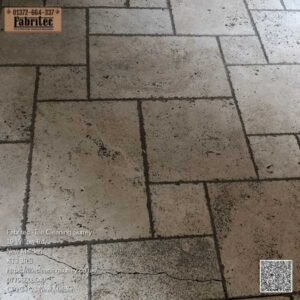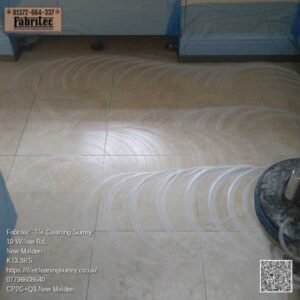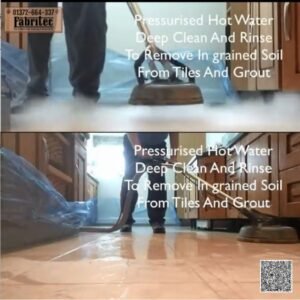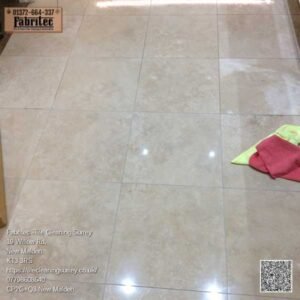Travertine floors radiate timeless charm and elegance, making them a top choice for discerning homeowners seeking to enhance their living spaces. Yet, employing incorrect cleaning methods can result in irreversible harm. If you reside in Kingston-upon-Thames and are considering the use of a steam cleaner on your stone floors, pause immediately. What might seem like a benign cleaning technique could lead to hidden damages that could be expensive to rectify. This comprehensive guide will explore the detrimental effects of steam cleaning travertine, offer tailored advice for effective maintenance, and suggest safer alternatives to keep your floors in pristine condition.
Explore the Unique Characteristics and Benefits of Travertine Flooring
Travertine is a distinctive type of limestone that forms through the deposition of minerals in hot springs. Its porous structure and softer texture, in comparison to granite, contribute to its natural, earthy aesthetic, enhancing the sophistication of any interior. However, this porosity also renders it susceptible to absorbing water, cleaning solutions, and dirt, highlighting the necessity for meticulous care. By comprehending the unique features of your travertine flooring, you can ensure it remains visually appealing and functional for years to come, preserving its beauty and integrity.
Travertine is available in a multitude of finishes that greatly influence both its appearance and maintenance:
- Honed: This finish offers a smooth, matte surface, highly desirable for flooring applications.
- Polished: This glossy, reflective finish appeals to those looking to add a touch of opulence to their space.
- Tumbled or Brushed: This option presents a rustic look with textured surfaces, creating a more natural ambience.
Understanding the specific type of travertine you possess is crucial before initiating any cleaning routine, as each finish reacts differently to moisture, heat, and physical stress. This knowledge will assist you in selecting the most effective cleaning methods to maintain your travertine's allure and longevity.
Assess the Dangers of Steam Cleaning Your Travertine Floors
In brief: The use of a steam cleaner on travertine floors is highly discouraged.
Understand How Heat and Moisture Can Compromise Travertine’s Integrity
Steam cleaners generate high-temperature vapour that is directed onto surfaces. Considering the porous nature of travertine, this can result in:
- Steam infiltrating the stone, potentially causing internal damage
- Long-term weakening or loosening of the stone’s structural integrity, jeopardising its durability
- Surface etching or a dull appearance, diminishing the stone's inherent beauty
Explore the Impact of Steam on Protective Sealants
It is vital to safeguard travertine flooring with a high-quality sealant. However, steam can:
- Penetrate and prematurely degrade the sealant, leaving the stone unprotected
- Induce microfractures within the stone, which can exacerbate over time
- Result in unsightly water marks and hazing on the surface, detracting from the aesthetics of your flooring
 Recognise How Steam Can Embed Dirt Within Travertine’s Pores
Recognise How Steam Can Embed Dirt Within Travertine’s Pores
While steam may initially dislodge dirt, without proper extraction, it can inadvertently force grime deeper into the stone, leading to:
- Gradual discolouration that becomes increasingly pronounced over time
- The development of soils within the stone, which can be challenging to eliminate

Essential Cleaning Techniques for Preserving Travertine Floors in Kingston-upon-Thames
 Opt for pH-Neutral Cleaners for Safe and Effective Care
Opt for pH-Neutral Cleaners for Safe and Effective Care
Avoid harsh alkaline or acidic cleaners, such as vinegar or bleach, as these can severely damage the quality of the stone. Instead, consider:
- Applying pH-neutral cleaners specifically formulated for natural stone
- Investigating local brands or UK-imported solutions that guarantee safety for your stone surfaces
 Employ a Damp Microfibre Mop for Gentle, Efficient Cleaning
Employ a Damp Microfibre Mop for Gentle, Efficient Cleaning
It is important to avoid using overly saturated mops that can harm your travertine. A damp (not wet) microfibre mop effectively cleans the surface without overwhelming it with excess moisture, thereby ensuring the longevity and aesthetic appeal of your flooring.
 Ensure Quick Drying After Mopping to Safeguard Your Floors
Ensure Quick Drying After Mopping to Safeguard Your Floors
Promptly drying travertine floors after mopping is crucial to prevent moisture seepage. To achieve this, you can utilise:
- Clean, dry cloths to soak up excess water
- Floor fans, particularly in areas with limited ventilation, to promote faster drying
 Re-Seal Your Floors Every 1–2 Years for Lasting Protection
Re-Seal Your Floors Every 1–2 Years for Lasting Protection
Given the humid climate in the UK, particularly in older homes in Kingston with restricted airflow, the frequency of sealing is essential for maintaining the structural integrity and appearance of your travertine flooring.
Smart Alternatives to Steam Cleaning for Your Travertine Floors
| Cleaning Method | Is it Safe for Travertine? | Additional Notes |
|---|---|---|
| Dry Dust Mopping |  |
Ideal for daily maintenance to keep surfaces clean and free from dust |
| Damp Mop with pH-Neutral Cleaner |  |
Recommended for weekly cleaning to uphold shine and cleanliness |
| Steam Mop |  |
Risks damaging the stone’s pores and sealant, leading to costly repairs |
| Acidic Solutions (such as Vinegar) |  |
Can corrode the stone's surface, resulting in permanent damage |
| Stone-Specific Cleaners |  |
Options include LTP Floorshine, LTP Waxwash, Fila Multi Surface Cleaner, and HG natural stone cleaner for a streak-free finish.
Always perform a spot test first to ensure compatibility. |
| Professional Stone Cleaning Services |  |
Ideal for deep cleaning and restoration, providing expert care and attention |
Identify Signs of Steam Damage on Your Travertine Flooring
- Dull patches or etched areas that detract from its overall beauty and appeal
- White haze or chalky residue indicating moisture-related issues
- Cracking or flaking that compromises the structural integrity of the stone
- Efflorescence, which appears as a white powder due to moisture migration
Discover Local Travertine Care Services in Kingston-upon-Thames
Travertine Care in Kingston-upon-Thames offers a specialised service combining modern cleaning techniques with the elegance of historical architecture. Many homes in this region feature traditional stone floors, and local homeowners, alongside property managers, can depend on professional travertine cleaning services provided by Fabritec Tile Cleaning, based in New Malden.
Is Your Travertine Floor Looking Dull and Grimy?

This homeowner in Kingston-upon-Thames possessed a stunning travertine floor, yet the tiles had lost their original grace following frequent cleaning with a domestic steam cleaner. The tiles became dull, soiled rapidly after cleaning, and absorbed stains like a sponge, significantly diminishing their allure.
Initially, the homeowner contemplated replacing the entire floor. Fortunately, they reached out to their local professionals, Fabritec, and that is where the restoration journey began.
Revitalising a Travertine Tiled Floor Through Expert Deep Cleaning
The first step involved restoring the stone's appearance and structural integrity through an extensive deep cleaning process. Travertine requires more than a simple wipe-down; effective cleaning necessitates mechanical abrasion and meticulous attention to detail.

- I began with a 200-grit pad attached to a rotary floor machine. By employing slow, circular motions, the pad effectively opened the stone's surface, allowing for the removal of deeply embedded dirt and worn finishes. This process generated a significant amount of slurry—a mixture of water and loosened stone particles—that required thorough rinsing and vacuuming.
- Following the initial pass, I progressed through a series of finer grits: 400-grit, 800-grit, and ultimately, 1500-grit. Each stage necessitated multiple passes to gradually refine the stone’s finish and enhance its natural luster. With each grit level, additional slurry was produced and meticulously extracted to ensure a clean, residue-free surface.
- Importantly, this restoration process is entirely mechanical—no chemical strippers were utilised, only water. The combination of abrasive pads and dedicated manual effort successfully revealed the stone’s inherent beauty.
Once the surface was restored to its former glory, attention turned to the grout lines, which were heavily soiled and did not respond well to pad cleaning. As rotary pads cannot effectively reach into recessed grout lines, I employed specialised equipment specifically designed for thorough cleaning.
Thorough Grout Cleaning: A Crucial Phase in the Restoration Process

I applied a robust stone-safe cleaner and degreaser, meticulously working it into the surface using a scrubbing machine. This technique effectively breaks down accumulated grime and emulsifies greasy residues lodged in the pores and grout lines. I allowed it to sit for approximately 10 minutes to penetrate and loosen the embedded soil.
Next, I utilised our high-pressure hot water rinse and capture system, which blasts hot water deep into the tiles. This process efficiently flushes out grime from both the grout lines and the natural pits in the travertine that scrubbing alone cannot reach.
Thanks to the heat and efficient vacuum extraction, the floor dries remarkably quickly. This rapid drying not only prevents moisture from reabsorbing into the stone but also prepares the surface for sealing sooner—often within an hour.
Applying Sealant to Your Travertine Tiled Kitchen Floor for Long-Term Durability

The homeowner expressed a desire to maintain a natural look, prompting me to apply a premium impregnating sealer specifically designed for polished stone surfaces, ensuring enduring protection and visual appeal.
Common Questions Regarding Steam Cleaning Travertine in Kingston-upon-Thames
What is the Optimal Method to Sanitize Travertine Without Steam?
Utilise a diluted pH-neutral cleaner alongside a microfibre cloth for effective sanitisation. For more comprehensive cleaning, consider hiring a professional service that specialises in stone care.
Is Professional Assistance Necessary for Re-Sealing My Travertine?
Not necessarily. While DIY kits are available, a professional ensures complete coverage and selects the most suitable product for your specific type of flooring, enhancing its durability and longevity.
What Consequences Arise If Water Accumulates on Travertine?
Standing water can infiltrate the stone, leading to dark patches, weakening the structure, and potentially fostering mould growth, which can be detrimental to your home environment.
Can Travertine Floors Be Polished After Experiencing Steam Damage?
Yes, minor etching or haziness may be rectified through honing and polishing. It is advisable to consult a stone care expert for optimal results in restoring the floor’s original beauty.
Essential Resources for Proper Travertine Care
The article Should You Steam Clean Travertine Floors? A Comprehensive Guide for Homeowners in Kingston-upon-Thames originally appeared on Tile Cleaning Surrey.
The Article Steam Clean Travertine Floors: Essential Guide for Homeowners appeared first on https://fabritec.org
The Article Steam Clean Travertine Floors: A Homeowner’s Essential Guide Was Found On https://limitsofstrategy.com

